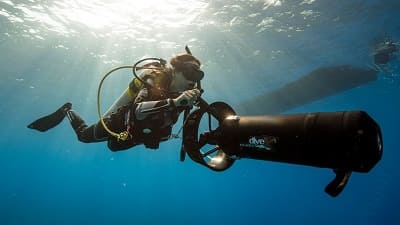Home › A-Z of Scuba Diving › Equipment › Diving Accessories › DPV
Underwater Propulsion Vehicle (UPV)
There are several reasons why some divers prefer to dive with an underwater propulsion scooter. But, one common reason is to reduce finning so the air supply lasts longer.
This section explains what a Diver Propulsion Vehicle (DPV) is, how they work, and why some underwater scooters are better than others - especially for beginners.
What is a DPV Scooter and Does it Go Fast?
In general, you will be able to cover a large area underwater if you are using a diver scooter. But, they are also handy for:
- Conducting underwater inspections
- Conserving your air consumption
- General exploration exercises
- Performing search and recovery operations
A dive scooter gives you the ability to navigate around the perimeter of large objects (e.g. shipwrecks) or reach out of the way dive sites.
This particular item of scuba diving equipment is motorised and battery-powered. As a result, only commercial and technical divers used them in large-scale practical applications - until quite recently.
Best Diver Propulsion Vehicle for Recreational Divers
Nowadays, DPVs have become popular with sport divers, mainly because they facilitate 'effortless' swims. Even so, because you'll be less active and water will be constantly running over your body, you should be wearing increased thermal protection to avoid issues with hypothermia.
It's important to be clear about the two different types. Unless you want to sit on (straddling) the device, you may be better suited to the type that has a handle. In other words, as the machine moves forward it will tow your body behind it.
 The 'ride on' type of scooter DPV tends to be bigger - and so they are more expensive.
The 'ride on' type of scooter DPV tends to be bigger - and so they are more expensive.
But, this model will provide most comfort over long journeys.
How Fast Can a Scuba DPV Diving Scooter Go?
Depending on which power setting you are using, it would be unusual for the battery to last more than two (2) hours.
Underwater scooters with adjustable speed options generally reach speeds up to five (5) kilometres per hour (3 mph).
Of course, the size, shape, and "streamlining" of the diver will have a significant effect on the ultimate operating speed.
Plus, managing the speed of the scooter conservatively will reduce the likelihood of running out of battery power before you need to surface (e.g. low air supply).
The DiveBuddy™ Seascooter
This could be an ideal replacement for the Torpedo 3500 dive propulsion vehicle and powering future underwater exploration - with a price tag around $650 (21,000 THB).
The DiveBuddy™ Seascooter is a compact, battery-powered underwater propulsion device that is designed and built to enhance adventures beneath the waves.
In more detail...
By reducing swimming effort and increasing range, this underwater propulsion vehicle (UPV) has become popular among scuba divers, snorkelers, and underwater photographers.
You can use it to glide effortlessly through the water, thereby conserving energy and air while you enjoy longer, more relaxed submersions.
How Does it Work?
At its core, the DiveBuddy™ Seascooter uses an electric motor housed within a hydrodynamic casing to drive the propeller.
When the user squeezes the dual trigger controls, the motor engages, pulling the diver forward through the water.
Speed settings are adjustable, allowing for smooth control and maneuverability especially when you are exploring coral reef networks, sunken shipwrecks, and when you're moving through open water.
A rechargeable lithium-ion battery provides up to ninety (90) minutes of runtime, depending on the speed and the conditions. It's also sealed to prevent water ingress even at depths exceeding thirty (30) meters (100 feet).
Safety and Convenience
Some of the safety features include automatic buoyancy control, ensuring it remains neutrally buoyant underwater.
It also has a safety lock to prevent accidental activation and a compact form factor that fits easily into most dive gear setups or boat storage.
What about photographers and videographers? The Seascooter enables steady, hands-free movement, allowing for smoother tracking shots and less camera shake.
By minimizing exertion, divers can also maintain better control of their breathing and buoyancy, leading to clearer, more composed footage.
Pro Tip: Taking the PADI® Diver Propulsion Vehicle Diver (scooter course) will help you learn how to pilot a scuba DPV in the water.
Related Information and Help Guides
- Best Surface Signalling Devices Used by Scuba Divers
- Dive Light for Scuba Diving (Underwater Torch for Beginners)
- Underwater Navigation Equipment Used in Scuba Diving
Pro Tip: The short video tutorial [2:23 minutes] presented by Global Underwater Explorers describes how to perform a barrel roll while using a high powered DPV diving scooter.